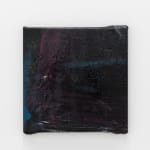Rindon Johnson
Magnificent Drain: ok pretend you don’t have a nose, or ears for that matter, or anything really, and pretend you’re flying and you’re not a bug, you’re you, and you hit a windshield and it doesn’t feel like you’re splattered across it, rather just becoming a part of it, either way it’s fine because you couldn’t hear it or smell it and I think, no I know, that would be the worst part, right?, 2023
Leather, crayon, oil, colored pencil, acrylic and wax
33.5 x 33.5 x 2 cm
13 1/4 x 13 1/4 x 3/4 inches
13 1/4 x 13 1/4 x 3/4 inches
Copyright The Artist
Photo: Dirk Tacke
Weitere Abbildungen
„Magnificent Drain [...]“ (2023) ist ein Wandobjekte aus Leder, das der Künstler mit Polyurethan, Bleichmittel, Mineralen und Farbstiften bearbeitet und so Spuren in die Hautoberflächen zeichnet. Für Rindon Johnson steht...
„Magnificent Drain [...]“ (2023) ist ein Wandobjekte aus Leder, das der Künstler mit Polyurethan, Bleichmittel, Mineralen und Farbstiften bearbeitet und so Spuren in die Hautoberflächen zeichnet. Für Rindon Johnson steht das Leder hier als Nebenprodukt und Relikt industrieller Verarbeitungsketten und zeigt einen umfassenden historischen Zustand auf, der den Umgang mit anderen Lebewesen verdeutlicht und sich auf das kolonialistische Erbe westlicher Staaten übertragen lässt. Wer und was kann zu den Nebenprodukten gezählt werden? Diese Frage verfolgt Johnson in der Werkserie, in dem er die Unterwerfung, Vernachlässigung und Austauschbarkeit von Nutztieren in unserer heutigen Zeit thematisiert und gleichzeitig Parallelen zu identitätspolitischen und klassistischen Themen wie Praktiken rassistischer Ausbeutung zieht. In den Arbeiten des Künstlers werfen die Titel auf poetische Weise zusätzliche Fragen hinsichtlich Autonomie und Macht auf. Johnsons Überlegungen gehen stets von den Möglichkeiten und der Qualität von Sprache aus und finden ihren Einfluss in Form der Titel, welche die Werke manchmal wie Gedichte begleiten. Die Titel zeichnen sich durch subjektive Eindrücke des Künstlers aus und entziehen sich bewusst einer eindeutigen Lesbarkeit.
“Magnificent Drain [...]” (2023) is a wall object made of leather. The artist manufactures visible traces on the hide by treating it with polyurethane, bleach, minerals, colored pencils, and exposure to weathering for months at a time. For Rindon Johnson, leather is a by-product and a relic of industrial processing chains, revealing a comprehensive historical and conceptual condition that illustrates the treatment of other living beings and can be applied to the colonialist legacy of Western states. Who and what can be counted as by-products? Johnson pursues this question in the work series, in which he addresses the subjugation, neglect and exchangeability of non-human actors in our contemporary times, while drawing parallels to identity politics and classist themes, as well as practices of racist exploitation. The poetic titles raise additional questions regarding autonomy and power. Johnson's reflections always start from the possibilities and quality of language and find their influence in the form of titles that accompany the works like poems. They are an essential part of the work, eluding clear readability through the artist's subjective impressions and deliberate ambivalences.
“Magnificent Drain [...]” (2023) is a wall object made of leather. The artist manufactures visible traces on the hide by treating it with polyurethane, bleach, minerals, colored pencils, and exposure to weathering for months at a time. For Rindon Johnson, leather is a by-product and a relic of industrial processing chains, revealing a comprehensive historical and conceptual condition that illustrates the treatment of other living beings and can be applied to the colonialist legacy of Western states. Who and what can be counted as by-products? Johnson pursues this question in the work series, in which he addresses the subjugation, neglect and exchangeability of non-human actors in our contemporary times, while drawing parallels to identity politics and classist themes, as well as practices of racist exploitation. The poetic titles raise additional questions regarding autonomy and power. Johnson's reflections always start from the possibilities and quality of language and find their influence in the form of titles that accompany the works like poems. They are an essential part of the work, eluding clear readability through the artist's subjective impressions and deliberate ambivalences.













